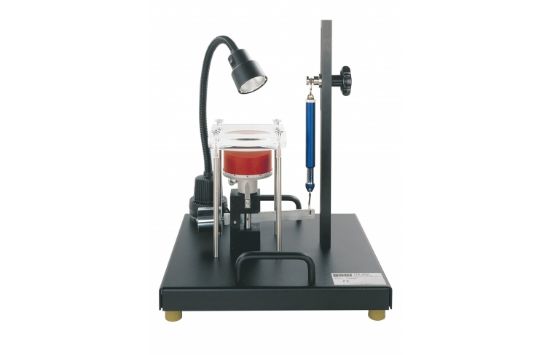When two bodies with a convex surface are pressed against each other, ideally, these bodies only come into contact linearly or at one or more points. In the real world, as the two bodies approach each other, an elliptical contact area occurs at the contact point due to deformation. In this case, the compressive stresses (compression) are proportionally distributed to the deformations.
Heinrich Hertz, a physicist, developed a theory to calculate the largest pressure, also known as Hertzian pressure. The size and shape of the contact areas and the extent and distribution of the mechanical stresses under the contact areas can also be calculated.
The TM 262 experimental unit demonstrates the shape of the occurring contact area under Hertzian pressure as an example. A rubber pressure pad is pressed against a transparent plastic plate via a lever. The plate and pressure pad are curved. Both circular and elliptical contact areas can be generated.
Using a spring balance, the force is measured at the lever and the contact force is determined. A halogen lamp at one side perfectly illuminates the contact area. Grid lines on the plastic plate make it easier to measure the contact area.

Hertzian pressure
When two bodies with a convex surface are pressed against each other, ideally, these bodies only come into contact linearly or at one or more points. In the real world, as the two bodies approach each other, an elliptical contact area occurs at the contact point due to deformation. In this case, the compressive stresses (compression) are proportionally distributed to the deformations.
Heinrich Hertz, a physicist, developed a theory to calculate the largest pressure, also known as Hertzian pressure. The size and shape of the contact areas and the extent and distribution of the mechanical stresses under the contact areas can also be calculated.
The TM 262 experimental unit demonstrates the shape of the occurring contact area under Hertzian pressure as an example. A rubber pressure pad is pressed against a transparent plastic plate via a lever. The plate and pressure pad are curved. Both circular and elliptical contact areas can be generated.
Using a spring balance, the force is measured at the lever and the contact force is determined. A halogen lamp at one side perfectly illuminates the contact area. Grid lines on the plastic plate make it easier to measure the contact area.
